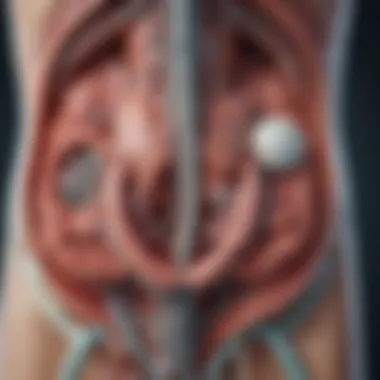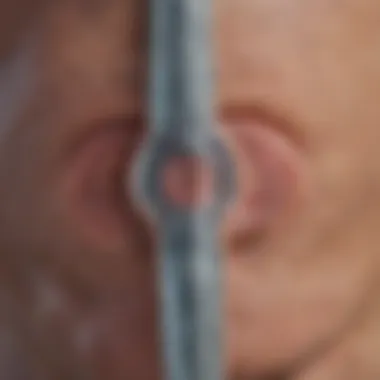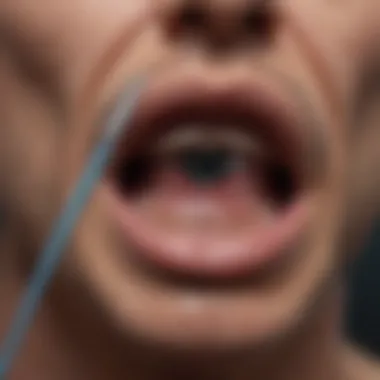Comprehensive Guide to Ureteral Stent Removal


Intro
The management of ureteral stents raises many questions among patients and healthcare providers. A ureteral stent is a flexible tube inserted into the ureter to facilitate urine flow from the kidney to the bladder. While the necessity of stenting is usually clear due to various medical conditions, the removal of these stents is often less understood. This guide aims to clarify the entire removal process, highlighting why stents are placed, what the removal entails, and the care required afterward.
Stent removal isn't just a routine procedure; it comes with its own set of considerations and potential complications. It’s important for patients and healthcare professionals alike to grasp the ins and outs of this process. Grasping the various aspects not only alleviates anxiety for patients but also sets appropriate expectations for outcomes and recovery.
A deep dive into the topic will enhance clarity and understanding, paving the way for healthier patient experiences and outcomes.
Overview of Ureteral Stenting
Ureteral stenting is a critical element in the management of urinary obstructions and various renal conditions. Understanding this procedure can illuminate the reasons behind stent placement and the essential follow-up care that patients require. Moreover, having insight into stenting procedures is invaluable not just for patients, but for healthcare professionals who are navigating this nuanced field.
Stents serve as a mechanical bridge, helping to maintain urinary flow from the kidney to the bladder, particularly when conditions like stones, tumors, or strictures obstruct normal pathways. This makes it imperative to recognize the implications of stenting on a patient’s health and quality of life.
Key Points about Overview of Ureteral Stenting
- Purpose: Stents are designed to alleviate obstruction, preventing potential complications like infection or kidney damage.
- Benefits: They offer patients immediate relief and can sometimes facilitate further diagnostic or therapeutic interventions.
- Considerations: Knowing the reason for stent placement, as well as its potential complications and the need for removal, can help guide patient discussions and expectations.
“An ounce of prevention is worth a pound of cure.”
Understanding ureteral stenting equips patients and healthcare providers with knowledge that can preempt discomfort and complications.
Definition and Purpose
Ureteral stenting involves placing a thin tube within the ureter to ensure unobstructed passage of urine. The primary purpose of this intervention is to relieve obstructions caused by various factors such as kidney stones, tumors, or post-surgical complications. Through this process, healthcare providers aim to protect kidney function and prevent any further renal impairment.
Indications for Ureteral Stenting
Stenting becomes necessary in a variety of clinical scenarios, including but not limited to:
- Urinary tract stones: When a stone obstructs urine flow, stenting can aid in drainage and comfort.
- Ureteral strictures: Narrowing of the ureter often necessitates stenting to maintain an adequate urine passage.
- Post-operative complications: After surgical interventions, stents may be placed to prevent or manage swelling and promote healing.
Types of Ureteral Stents
There are several categories of ureteral stents, each selected based on individual patient needs and specific clinical circumstances. Key types include:
- Double-J Stents: These feature a curled end that prevents migration out of the ureter. They are very common and typically well tolerated by patients.
- Single J Stents: Mostly utilized in outpatient settings for short-term relief, helping manage simpler obstructive issues.
- Open-Ended Stents: These may be used in certain conditions to improve urine drainage without the curls of traditional options.
Each stent type carries its own set of benefits and potential complications, making it crucial for medical professionals to choose wisely based on the patient's medical history and specific needs.
Stent Placement Procedure
The stent placement procedure is a critical step in managing urinary tract obstructions and other related conditions. The importance of this section in our guide lies in its overarching influence on patient outcomes, ensuring that the body can effectively handle urinary flow where anatomical or pathological issues exist.
When we talk about ureteral stents, we’re not just referring to a piece of medical equipment; we’re discussing a lifeline for patients facing serious health concerns. The placement of a stent can alleviate symptoms, prevent further complications, and facilitate the healing process. Thus, it’s imperative to understand the entire scope of the procedure, from preoperative assessments to postoperative care.
Preoperative Assessments
Before any procedure, a thorough preoperative assessment lays the groundwork for success. This phase usually includes an evaluation of the patient's medical history and current health status. Key factors often involve:
- Imaging Studies: CT scans or ultrasounds may be used to determine the location and nature of the obstruction.
- Kidney Function Tests: To ensure that renal function is not significantly compromised and will not deteriorate further due to the stenting procedure.
- Allergy Checks: Assessing any known allergies to medications or materials used during the procedure, such as dyes or anesthetics.
This preparatory phase is where discussions about expectations occur. Patients should feel encouraged to voice concerns or ask questions. Effective communication with healthcare providers helps buffer anxiety and establish trust—essential components of successful medical outcomes.
Surgical Techniques for Placement
The surgical techniques for placing ureteral stents can vary according to specific patient needs, but generally, the process is fairly standardized. The two common approaches include:
- Cystoscopy: This is the most frequently used technique. A thin tube with a camera is inserted through the urethra into the bladder. The physician can visualize the ureters and perform the placement of the stent directly into the ureter.
- Percutaneous Nephrostomy: In more complicated cases, for example, when cystoscopy is not viable, this method involves making a small incision in the back to insert a catheter directly into the kidney. A stent can then be placed through this access point.


During these procedures, ensuring patient comfort is paramount. While risks exist, proper surgical techniques aim to minimize complications such as bleeding or infection. The skills of the surgeon play a vital role in the outcome, necessitating a high level of proficiency.
Postoperative Recovery
Once the stent is in place, postoperative recovery begins. This stage shouldn’t be overlooked—it can significantly impact overall results. During recovery, patients may experience a range of symptoms, including:
- Mild Discomfort: It’s common for patients to feel some degree of pain or burning during urination.
- Hematuria: Blood in the urine can occur, which typically resolves on its own but should be monitored closely.
- Increased Urgency or Frequency: Due to the stent’s presence, alterations in urination patterns may arise.
The recovery phase is also the ideal time for healthcare professionals to educate patients about potential symptoms that merit follow-up visits. Reminders to stay hydrated, manage pain effectively, and recognize warning signs can empower patients, ultimately leading to better health outcomes.
"A penny saved is a penny earned," and in this context, knowledge gained pre and post-op can lead directly to a healthier recovery.
In essence, the stent placement procedure is not simply a mechanical intervention. It serves as the foundation for effective treatment, encompassing preparatory assessments, surgical precision, and recovery support—all critical facets that pave the way for a successful outcome.
Reasons for Ureteral Stent Removal
Understanding why ureteral stents must be removed is crucial for both patients and healthcare professionals. The need for removal is determined by various medical and patient-specific factors, each contributing to the effective management of ureteral conditions. Addressing these reasons helps in planning the care pathways and ensuring that patients experience optimal outcomes.
End of Therapy
The conclusion of a stent's purpose is one of the primary reasons for its removal. Stents are often installed to assist in urine flow during periods of obstruction or after surgical procedures. Once the underlying issue is resolved, the stent must be extracted to avoid unnecessary complications that may arise from its prolonged presence. Let’s say someone has a kidney stone that obstructs the ureter. After a few weeks, they may go through either a lithotripsy procedure or another treatment, resolving the blockage. This is the point where stent removal becomes essential, ensuring that the patient returns to normal urinary function without the stent potentially causing infection or irritation.
Key Takeaways:
- Removal signifies restoration of urinary function.
- Prevents complications related to long-term stent presence.
Complications and Symptoms
Stent removal may also be necessitated by complications or symptoms that arise after placement. Postoperative challenges could include infection, ureteral perforation, or symptoms like severe pain and discomfort. For instance, if a patient starts to exhibit signs of infection, such as fever or severe back pain, immediate intervention is required. The medical team might decide that the stent's presence is exacerbating the patient's issues, requiring consideration for removal before further complications develop.
Here are potential complications that may prompt removal:
- Urinary tract infections (UTIs)
- Pain and dysuria
- Stent migration
- Encrustation
"Addressing complications promptly can avoid more severe outcomes down the line."
Patient-Specific Factors
Every patient is unique, and their specific circumstances can significantly influence the decision surrounding stent removal. Factors like a patient’s overall health, preexisting conditions, or concurrent treatments can dictate how long the stent remains in place. For a patient undergoing cancer treatment that affects the urinary tract, ongoing assessments might indicate varied timelines for removal based on their health status and treatment effectiveness. Moreover, some patients may have preferences based on their pain tolerance and quality of life considerations. Understanding these nuances is crucial in managing patient care effectively and ensuring that stent removal aligns with their individual needs.
In summary, reasons for the removal of ureteral stents encompass a variety of considerations. Recognizing the end of therapy, understanding potential complications, and evaluating patient-specific factors all contribute to informed decision-making regarding the removal process. These aspects not only facilitate patient safety but also enhance overall treatment efficacy.
The Removal Procedure
The removal of ureteral stents is a significant part of stent management, signaling either the conclusion of a therapeutic phase or the necessity for further evaluation. Understanding this procedure is pivotal for both patients and healthcare professionals, enhancing patient outcomes and ensuring proper follow-up care. When the time comes to remove these stents, several factors come into play, including preparation, technique, and pain management during the process.
Preparation for Removal
Preparation is half the battle won when dealing with ureteral stent removal. This phase starts with ensuring that the patient is fully briefed on what to expect. Communication is key; clarity regarding the procedure alleviates some apprehensions.
- Patient Assessment: Before proceeding, healthcare providers may conduct assessments. This generally includes a review of the patient’s medical history, recent urinalysis, or imaging studies to assess stent position and function.
- Documentation & Consent: An essential aspect is obtaining informed consent. This document outlines the risks and benefits, ensuring the patient understands the process fully.
- Pre-Procedure Instructions: It's also crucial to provide instructions, such as whether the patient should avoid certain medications, fast before the procedure, or arrange for post-removal transportation, as they may experience lightheadedness from sedation.
In this stage, a calm environment can help decrease anxiety levels, helping the patient feel like they’re in capable hands.
Technical Aspects of Removal
When the actual time for the removal arrives, the technique used becomes vital. Ureteral stents can be removed using a couple of different approaches:
- Cystoscopy: This minimally invasive procedure involves inserting a thin tube with a camera through the urethra into the bladder. The provider can then locate the stent arm within the bladder and gently pull it out using specially designed tools.
- Retrieving Stent Strings: In cases where stents have strings, which is fairly common, the provider will locate these strings and can pull them out without the same level of invasiveness.


During this process, it’s critical to maintain a steady hand and be keenly aware of the stent’s position, as missteps could lead to discomfort or complications. Each technique has distinct considerations, and the choice often depends on patient factors and stent specifics.
Pain Management during the Procedure
Even though many patients worry about pain during removal, the procedure is generally considered less discomforting than initial placement. Nevertheless, effective pain management is paramount to ensure patient comfort.
- Topical Anesthetic: In most cases, a local anesthetic is applied in the bladder to minimize sensations during removal. This can be particularly comforting for those who are understandably anxious.
- Sedation: For patients with heightened anxiety or sensitivities, mild sedation might be administered. This ensures they are relaxed yet still able to respond if necessary.
- Post-Procedure Pain Control: After the stent removal, patients are often advised to monitor their discomfort levels. Providing them with information on over-the-counter pain management options may help alleviate any discomfort they might experience following the procedure.
"Managing pain effectively not only eases the immediate experience but also fosters trust in the medical team and encourages positive recovery outcomes."
With proper technique, preparation, and pain management strategies, ureteral stent removal can be a smoother experience for patients, promoting better overall satisfaction with their healthcare journey.
Post-Removal Considerations
When a ureteral stent is taken out, several aspects come into play that are crucial for both the patient’s wellbeing and the effectiveness of their treatment. Understanding post-removal considerations helps in managing recovery, watching for any complications, and ensuring long-term health. This section dives into the elements that must be kept in mind to facilitate a smooth transition post-procedure.
Immediate Aftercare
After the stent removal, immediate care is vital. Patients often experience discomfort or may feel residual effects that could complicate recovery. Here are some important aftercare practices:
- Stay Hydrated: Drinking ample water aids in flushing out any remnants or debris that might be left behind.
- Pain Management: Over-the-counter pain relievers such as ibuprofen or acetaminophen can help ease any discomfort. Always consult your physician about suitable options.
- Activity Modification: Avoid strenuous activities for at least a few days. This includes heavy lifting or rigorous exercise which might aggravate the surgical site.
It’s essential to follow your provider’s specific instructions and reach out if any unusual symptoms arise.
Monitoring for Complications
Postoperative monitoring is a critical part of recovery. Certain complications may appear that need immediate attention. It’s important for patients and caregivers to be vigilante about observing the following signs:
- Fever or Chills: Elevated body temperature can signal an infection that may need medical intervention.
- Severe Pain or Discomfort: While some pain is expected, sharp or increasing pain may indicate complications.
- Changes in Urination: Issues such as blood in the urine, increased frequency, or pain should not be ignored.
- Unusual Swelling: Swelling around the surgical area can be a warning sign of a more serious underlying issue.
Should any of these symptoms present themselves, it's advisable to contact a healthcare provider promptly for guidance.
Long-Term Effects and Follow-up
Even after the initial recovery phase, patients need to remain aware of potential long-term effects of stent removal. Regular follow-up appointments are essential to monitor any changes in kidney function or urinary symptoms.
Long-term considerations include:
- Regular Monitoring: Follow-up imaging or lab tests may be required to ensure there are no lasting complications from the stenting procedure.
- Adapting to Changes: Adjusting lifestyle factors, such as hydration and diet, could promote better urinary tract health and function.
- Open Communication: Always inform your healthcare provider about any new or lingering symptoms experienced after removal. They might adjust the management plan accordingly.
"Regular follow-ups are not just a routine; they are a proactive approach to maintaining health post-stenting."
Understanding post-removal considerations ensures that patients are better equipped to navigate their recovery. Being diligent about aftercare, monitoring for complications, and committing to long-term health management can significantly enhance the overall outcome.
Potential Complications
In the realm of ureteral stenting, attention to potential complications is not merely an afterthought. Rather, it serves as a cornerstone of patient management and education. Understanding these complications not only helps patients make informed choices but also empowers healthcare providers to anticipate and mitigate risks during and after the stent removal process. Stent-related complications can significantly influence a patient’s recovery trajectory and overall well-being.
Infection Risks
One of the most pressing concerns after ureteral stent placement and removal is the risk of infection. The stent can be a foreign body in the urinary tract, providing a surface for bacteria to thrive. The most common infection that arises is urinary tract infection (UTI), which can manifest symptoms like fever, chills, and discomfort during urination.
Patients should be vigilant about signs of infection, as it may develop during the period of stenting or following removal. Healthcare professionals often prescribe prophylactic antibiotics to decrease the chances of this occurrence, especially if a stent is left in place for longer durations. The interplay between stent duration and infection risk can be crucial, as longer stent placements correlate with increased infection rates.
"Awareness is the first step toward prevention. Recognizing infection symptoms early can drastically change outcomes."
Injury to Surrounding Structures
The act of removing a ureteral stent is generally straightforward, yet the potential for injury to surrounding structures warrants significant attention. Missteps during removal can lead to damage in adjacent organs, such as the bladder or ureters. Such injuries may cause immediate and profound complications, ranging from bleeding to perforation.


Surgeons must employ careful techniques during the extraction to minimize risks. Utilizing imaging guidance, for instance, can provide real-time feedback, ensuring the stent’s pathway remains clear. Understanding anatomical variations among patients also plays an important role in this process. Post-procedure care should include monitoring for unusual pain or changes in urinary habits, as these can hint at underlying issues related to surrounding tissue trauma.
Recurrent Symptoms
Some patients may experience recurrent symptoms even after the ureteral stent has been removed. This can range from discomfort or pain during urination to persistent lower back pain. Understanding the reasons behind these recurrent symptoms is critical for both physicians and patients. Factors such as residual bladder irritation or underlying urinary conditions, that were previously masked by the stent, may re-emerge after its removal.
Monitoring these symptoms can guide further diagnostics or interventions, ensuring that complications don’t get swept under the rug. Patients should be encouraged to communicate openly with their healthcare providers about any persisting discomfort post-removal.
In summary, being alert to potential complications associated with ureteral stent removal is vital for optimal patient care. It’s not about fearing the process but mastering it through education and awareness.
Patient Education and Empowerment
Patient education and empowerment is a cornerstone in the realm of ureteral stent management. Understanding what stenting entails, why it’s necessary, and how to navigate post-procedure life can significantly influence recovery outcomes and overall satisfaction with treatment. Knowledge acts as a buffer, easing uncertainty and fostering cooperation between healthcare providers and patients.
Understanding the Stenting Process
To grasp the intricacies of ureteral stenting, patients need education on the entire process, from placement to removal. Stenting typically begins when a healthcare professional determines a blockage or issue with the ureter. Focused discussion about the rationale for stenting can clarify:
- Purpose: Why is a stent needed? What conditions are being addressed?
- Duration: How long is the stent likely to remain in place?
- Outcomes: What improvements can be expected? Are there any foreseeable complications?
This knowledge simplifies a potentially daunting experience.
Recognizing When to Seek Help
Post-stenting, patients must be vigilant. They should be able to discern when symptoms necessitate professional intervention. Awareness about specific warning signs is crucial:
- Increased pain or discomfort that doesn’t fade.
- Any signs of fever or chills, indicating possible infection.
- Changes in urinary patterns, such as blood in the urine or drastic alterations in frequency.
Recognizing these symptoms is not merely beneficial; it can be life-saving. By encouraging patients to trust their instincts and inform their doctors about concerning changes, healthcare providers empower them.
Resources for Further Learning
Informing oneself doesn't stop with an initial consultation. Patients can enhance their understanding through numerous resources:
- Websites: Platforms such as Wikipedia and Britannica provide scientifically vetted information.
- Support Forums: Engaging with communities on Reddit or Facebook can offer personal experiences that might resonate and provide comfort.
- Educational Materials: Pamphlets or online videos offered by healthcare facilities can clear up questions about stent care.
"An informed patient is likely to achieve better health outcomes."
The Future of Ureteral Stenting Practices
The future of ureteral stenting practices holds immense potential, particularly in light of rapid advancements in medical technology and techniques. As medical professionals continue to seek out more effective, less invasive treatments, the landscape of ureteral stenting is becoming increasingly sophisticated. This hinges on a few key elements that can dramatically improve patient outcomes and streamline medical protocols.
One crucial aspect is the continuous evolution of stent design. The incorporation of innovative materials and methods suggests that stents are not merely static devices used as a catch-all solution, but rather tailored tools that can adapt to the specific needs of a patients. This means that future designs may prioritize biocompatibility and minimize irritation, addressing one of the common complaints associated with traditional stents.
Innovations in Stent Design
The exploration of new materials like bioresorbable stents is paving the way for major breakthroughs. Unlike conventional stents, these bioresorbable counterparts can dissolve safely in the body, reducing the need for multiple procedures. This could potentially eliminate the discomfort and complications tied to stent removal—akin to designing a one-size-fits-all approach that actually fits.
Furthermore, smart stents that monitor physiological changes in real-time are being developed. Imagine stents that can communicate with physicians, alerting them to any signs of complications or inefficiencies. This tech-savvy approach not only fosters proactive care but may also become the gold standard in managing ureteral obstructions in the years ahead.
Emerging Techniques in Stent Removal
As we look to the future, it’s crucial to take note of the emerging techniques in stent removal. The traditional methods, while effective, can be quite uncomfortable and pose various risks to the patient. Techniques utilizing minimally invasive endoscopic procedures are being refined, aiming to lessen both discomfort and recovery time. These advanced modalities not only improve safety but can also enhance the overall experience for patients.
Moreover, robotic-assisted surgeries, which have gained considerable traction in other areas of urology, are slowly finding a hint in stent removal. Utilizing robots may provide surgeons with a level of precision unmatched by human hands alone. Such advancements might just symbolize a turning point in how medical professionals approach the intricacies of ureteral stent removal.
Importance of Continuing Education for Providers
In light of all these developments, the importance of ongoing education for providers cannot be overstated. As new techniques and technologies emerge, it’s vital that healthcare professionals stay abreast of these changes. Continuous learning not only enhances the skills of practitioners but ensures that they can offer the best possible outcomes for their patients.
This commitment to education should encompass more than just formal training. Providers can participate in workshops, seminars, or conferences that focus on advancements in urology—sharing knowledge and experiences with one another. Such collaborative environments foster innovation and improvement in care methodologies.
"As with any area of medicine, staying current in ureteral stenting practices ensures that both patients and providers benefit from shared knowledge and newly embraced techniques."
The future of ureteral stenting practices is bright, informed by a commitment to innovation, patient-centered approaches, and a dedication to continuous improvement in education for all practitioners. Collectively, these changes promise not just better health outcomes, but also a more streamlined healthcare experience for patients of all walks of life.



